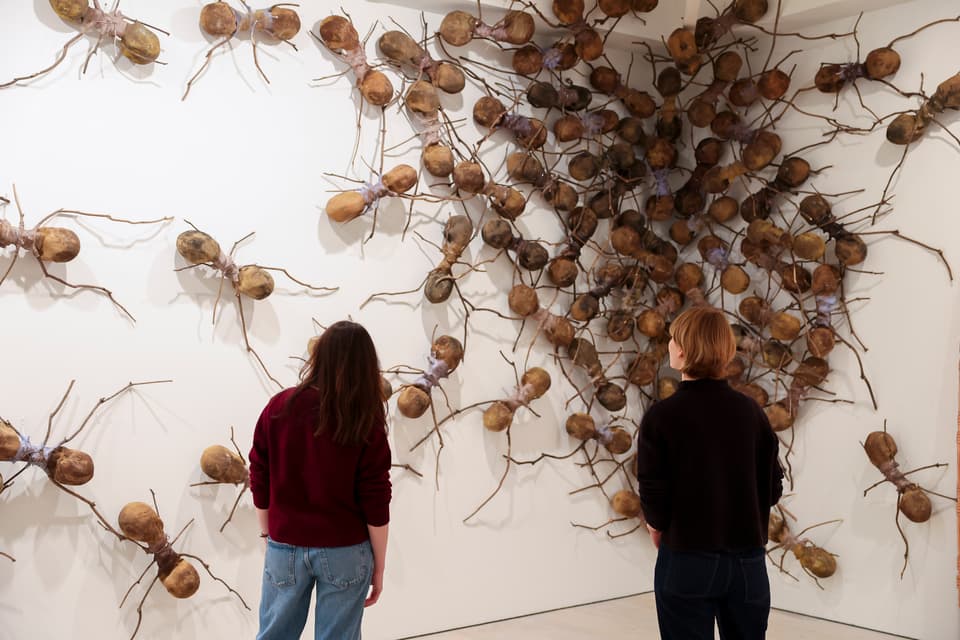Review at a glance
How valuable is shock in art? As Charles Saatchi recognised with his sideshow barker role to the YBAs carnival of horrors, very valuable indeed. But, once the dust has settled — and it just about has now, three decades and several decaying sharks on — how valuable is shock to art?
A grown-up would say that art should not be about shock at all, it should be about the integrity of the work, the fulfilment of the artist’s vision, and if it shocks, that’s society’s stuffy fault. Yet the very nature of conceptual art — from Duchamp’s Pissoir onwards — is to cause a reaction, with the ideal reaction being outrage. This is what the Saatchi Gallery made its reputation on, as the enfant terrible gallery. And Saatchi knew how to market that outrage. Duchamp, but with PR. But did that era have true artistic importance, beyond making for a nice segment in I Love the 90s?
The Long Now, an exhibition that celebrates 40 years of the Saatchi, is not a mere YBA retrospective to tie into with the Oasis reunion but a casually swaggering showcase for its role in the lineage of art and how it continues to showcase and inspire contemporary artists. In nine rooms over two floors, the intermingling of big names and rising stars is hit and miss but convinces you that contemporary art is alive and kicking hard.

Casa Tomada by Rafael Gómezbarros
Matt Chung
Before and beyond the YBAs
The stand-outs are when legendary works from the past are reinvented. Allan Kaprow’s Yard — first presented in New York in 1961 — consists of a big heap of tyres which visitors are encouraged to climb on, move and get their hands dirty with. Here, it has been mashed up in deliciously absurdist style with Conrad Shawcross’s Golden Lotus (Inverted), a naff old 1980s Lotus “supercar” suspended upside down from the ceiling, where it spins over the tires as Mylo pounds out of the speakers. This is all about decadence and waste reclaimed by the creative human spark, but its loud immediacy goes straight to your nervous system.
There’s also Rafael Gómezbarros’s Casa Tomada, with its giant ants bursting across the walls and ceiling. The thrill of the sight quickly becoming chilling when you come close to find these ants are made from human skulls. Displaced migrants are the subject here, the unwelcome truths of their deaths coming crawling out like ants to confront us.
There’s plenty of YBAs here, mostly showing recent work. Gavin Turk’s Bardo is a degrading maze to get lost inside, an experiential representation of societal decline and degradation that really does make you feel lost (panicked actually). Jake Chapman’s series of paintings and sculptures use acid house student poster colours to take on pseudo-spirituality — Krystallemethalwellnesslessnessmess is a mash-up of crystals, yoga and furious “self-love” — to expose it as sweatshop-fuelling voodoo con perpetuated by actual demons; listing as one of the materials in these works “the artist’s tears” is worth the price of admission alone.
Nearby — and following her National retrospective, 2025’s best show — Jenny Saville’s immense painting of a nude trans woman, Passage, with genitalia front and centre, is a grand moment of defiance which acts almost as a beckoning on to the other artists. And there is some fine work here from new generations. Rannva Kunoy’s paintings seem to capture shifting light on the surface of the canvases while presenting codes and riddles that bring an inevitable digital eeriness, like Ouija boards.

Richard Wilson 20:50
Matt Chung
Not everything is up to scratch. Much of the AI video work is liable to leave you cold. Chino Moya’s Unitive Knowledge of the System’s Dynamic (2025) is a series of videos showing a future world ruled by computers where the population exists in total leisure time and, at a loss, recreates rituals of work and religion without any reason or belief. It takes up a vast space when one video will do… we get it, OK, let’s kill HAL.
You can smell the big climax before you see it. Richard Wilson’s 20:50 has been presented at every Saatchi Gallery building through the years and at the Duke of York’s HQ is in the very top floor, the monster in the attic whose stench seeps down through the other rooms. Enter the room — half-full with recycled engine oil, shining, still and ominous — to have a near-religious experience, though one where God may appear out of the murk to tick you off.
If there’s anything that unites the vast display of different artists from the gallery’s history here, it’s a mixture of artistic flamboyance, street-smart satire and an edgy savage spirit. These are works that seize you by the shoulders. Long may it continue.

